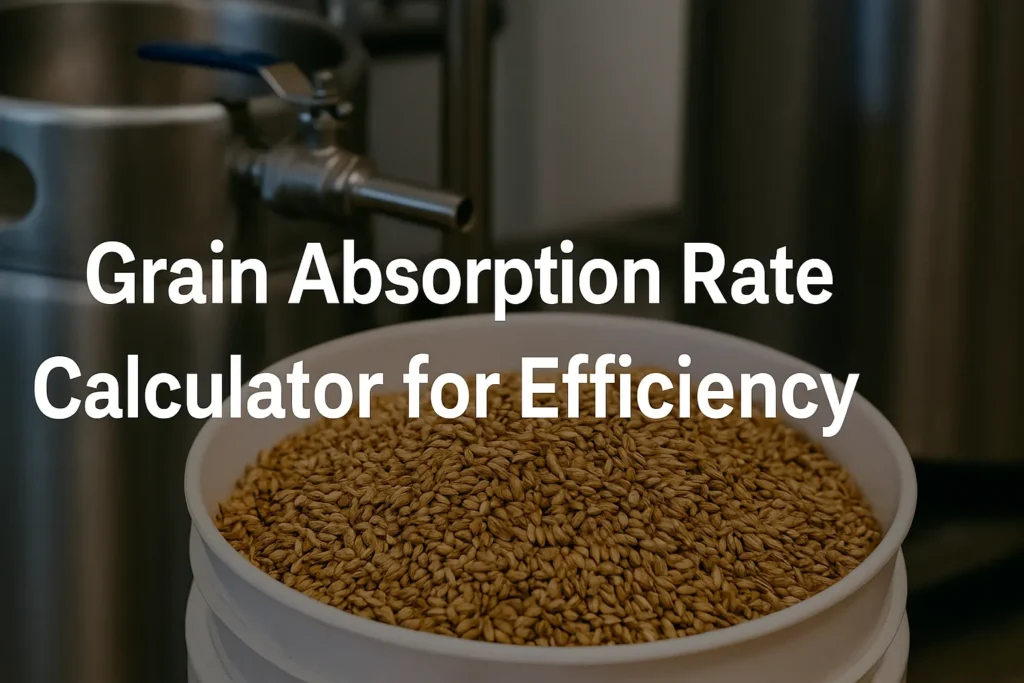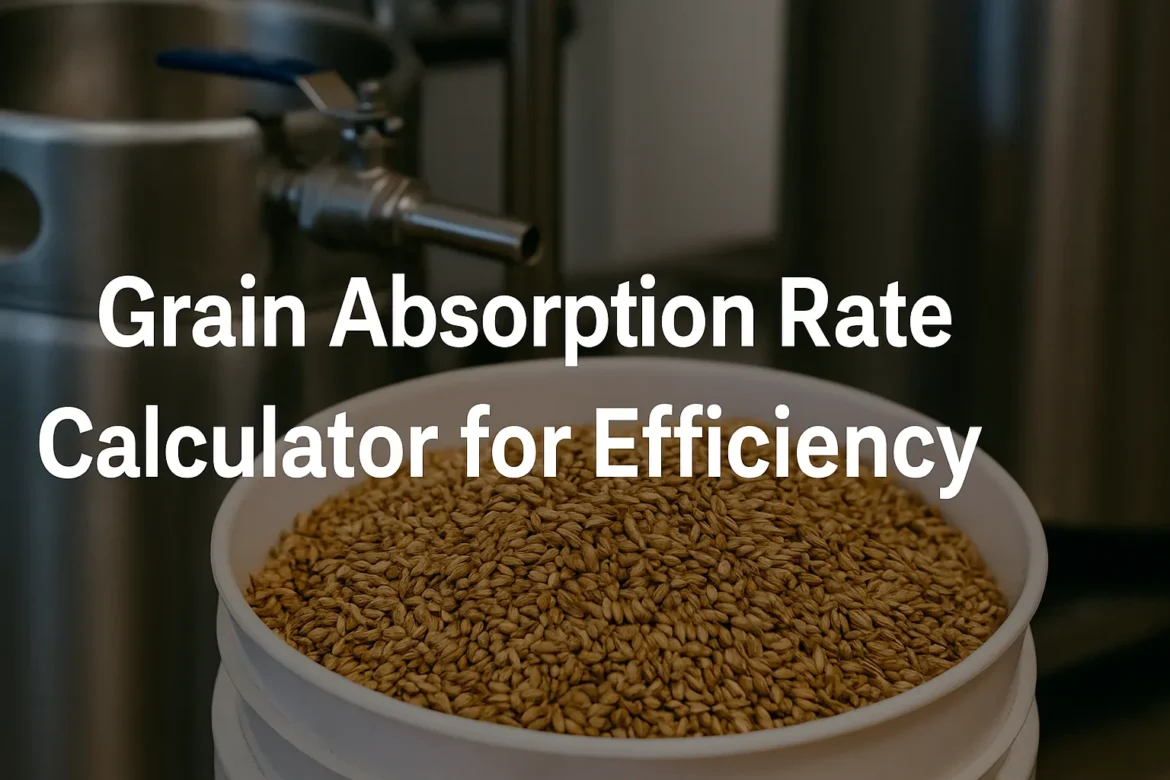Master brewing efficiency with our grain absorption rate calculator. Calculate precise water volumes, optimize mash performance, and achieve consistent results with professional brewing formulas and expert guidance.
Calculating grain absorption rates accurately transforms amateur brewers into efficiency masters. Understanding how much water your grains absorb during mashing directly impacts your final beer volume, gravity readings, and overall brewing success. Professional breweries rely on precise grain absorption rate calculators to maintain consistency, and homebrewers who master these calculations achieve dramatically improved results with every batch.

Understanding Grain Absorption Rate Calculator Fundamentals
A grain absorption rate calculator determines exactly how much water grains retain during the mashing process. This absorbed water never makes it to your kettle, affecting everything from pre-boil volume to final alcohol content. Figure 1/2 quart per pound of grain. This comes out to ~1 pint (0.125 gallons) / pound of grain. Some reports are as high as 0.2 gallons per pound, according to Brewer’s Friend, highlighting the variability that makes accurate calculation essential.
The absorption process occurs when crushed grains soak up water during mashing. Grain is relatively porous, and can hoover up a considerable amount of water during this process. Understanding this mechanism helps brewers predict water requirements and maintain recipe consistency across multiple batches.
The Science Behind Water Absorption
Water absorption varies significantly based on several factors including grain type, crush size, mash thickness, and even environmental humidity. Using a grain bill of 23 pounds, for a 10 gallon batch, when squeezing the grain I use .075 gallons per pound to determine grain absorption. When not squeezing the grain using .125 gallons per pound seems to be the accepted absorption rate, demonstrating how brewing technique affects final calculations.
Essential Grain Absorption Rate Calculator Formula
Basic Calculation Method
The fundamental grain absorption rate formula follows this structure:
Grain Absorption Rate = (Strike Volume – First Runnings Volume) / Grain Weight
Where:
- Strike Volume: Initial water added to mash
- First Runnings Volume: Liquid extracted before sparging
- Grain Weight: Total weight of grain bill
🌾 Grain Absorption Rate Calculator
Optimize brewing efficiency with precise water management
📊 Calculation Method
📈 Absorption Rate Results
📋 Water Volume Breakdown
Quick Reference: Grain Absorption Rates
| Grain Type | Absorption Rate (gal/lb) | Typical Range | Notes |
|---|---|---|---|
| Base Malts | 0.10-0.125 | Standard | Most predictable |
| Wheat Malts | 0.15-0.18 | Higher | Increased protein content |
| Rye Malts | 0.15-0.18 | Higher | Similar to wheat |
| Crystal Malts | 0.10-0.15 | Variable | Depends on color |
| Roasted Malts | 0.08-0.12 | Lower | Less porous structure |
Advanced Calculation Considerations
Professional brewers use more sophisticated formulas accounting for multiple variables:
Total Water Absorbed = (Grain Weight × Absorption Rate) + Equipment Losses + Dead Space
| Grain Type | Absorption Rate (gal/lb) | Typical Range | Notes |
|---|---|---|---|
| Base Malts | 0.10-0.125 | Standard | Most predictable |
| Wheat Malts | 0.15-0.18 | Higher | Increased protein content |
| Rye Malts | 0.15-0.18 | Higher | Similar to wheat |
| Crystal Malts | 0.10-0.15 | Variable | Depends on color |
| Roasted Malts | 0.08-0.12 | Lower | Less porous structure |
Brewing Method-Specific Calculations
Traditional All-Grain Systems
Traditional three-vessel systems require precise calculations due to multiple transfer points. The typical home brewer will be using a range of 1-1.5 quarts of water per pound of grain. Don’t stress mash thickness at this time, find a ratio that will work for your equipment. The average ratio is 1.25qts/pound, providing a solid foundation for absorption calculations.
Strike Water Volume = Weight of Grain × Desired Mash Thickness
For example, with a mash thickness of 1.25 quarts per pound and 10 pounds of grain: Strike Water Volume = 10 lbs × 1.25 qt/lb = 12.5 quarts
Brew-in-a-Bag (BIAB) Considerations
BIAB systems show different absorption characteristics due to grain handling differences. Typically, one pound of BIAB can be expected to absorb 0.1 gallon, though this can sometimes go as high as 0.125 gallons, making accurate calculation crucial for volume predictions.
BIAB brewers often achieve lower absorption rates through aggressive squeezing techniques. I squeeze pretty well, but nothing too crazy. so 64 liquid ounces per 192 grain ounces. about .33 fl oz/ oz. is about right by my simple math, demonstrating how technique affects final numbers.
Advanced Efficiency Optimization Strategies
Mash Thickness Impact on Absorption
Mash thickness directly affects absorption rates and brewing efficiency. The water to grist ratio is one of the least significant factors in influences mash performance the typical range of these mash ratios is 1-2 US qt/lb (2-4L/kg). Within this range, the effect of the mash ratio of fermentability is less than 5%, according to Palmer’s research.
However, extreme ratios create problems:
- Thick mashes (< 1 qt/lb): Slower conversion, higher absorption
- Thin mashes (> 2 qt/lb): Enzyme dilution, extended times
Temperature Effects on Water Management
Temperature significantly impacts water density and absorption calculations. With commercial breweries and homebrewers that use three-vessel systems, where a large hot liquor tank is used to preheat water to strike or first mash temp. then the change in density needs to be considered when measuring out the water.
Water density changes:
- 4°C (39.2°F): 1.000 density
- 20°C (68°F): 0.998 density
- 60°C (140°F): 0.983 density
Equipment-Specific Loss Calculations
Mash Tun Dead Space
Every mashing system has dead space where liquid remains unrecoverable. Dead space varies by equipment. Some of the water / sweet wort is left behind because of the shape of the mash tun or location of the valve. I estimate 2 quarts (0.5 gallon) in my cooler mash tun, providing realistic expectations for hobbyists.
System Loss Factors
| Equipment Loss | Typical Volume | Impact on Efficiency |
|---|---|---|
| Mash Tun Dead Space | 0.5-1.0 gallons | Direct volume loss |
| Transfer Lines | 0.1-0.3 gallons | Minimal but consistent |
| Pump Dead Space | 0.2-0.5 gallons | Equipment dependent |
| False Bottom | 0.3-0.7 gallons | Design dependent |
Practical Measurement Techniques
Direct Measurement Method
The most accurate approach involves direct measurement during brewing. Simply measure how much water you have at the start of your mash, and the water remaining in the extracted wort during sparging. The difference between these two numbers is your grain absorption rate.
Brewing Software Integration
Modern brewing software incorporates grain absorption rate calculators with equipment profiles. For comprehensive brewing calculations and system optimization, visit Brew My Beer for advanced brewing tools and efficiency optimization guides.
Advanced brewing software now incorporates real-time absorption rate adjustments based on environmental conditions and grain characteristics. Professional brewers can access sophisticated tools through platforms like Brewfather and BeerSmith for comprehensive recipe management and system optimization.
Empirical Testing Protocol
- Pre-Mash Measurement: Record exact strike water volume
- Post-Mash Collection: Measure first runnings accurately
- Sparge Documentation: Track all water additions
- Final Calculation: Apply absorption formula
- System Calibration: Adjust future recipes accordingly
Troubleshooting Common Absorption Issues
Inconsistent Results
Figuring out grain absorption can be a little tricky, because there are so many factors at play. The grain itself and how it’s crushed and mashed can play a part in grain absorption, but also something as unpredictable as the humidity on the day can alter this.
Common Variables:
- Grain moisture content variations
- Crush consistency changes
- Mash temperature fluctuations
- Environmental humidity effects
- Equipment temperature differences
Calculation Accuracy Problems
Your method for measuring/calculating grain absorption rate is not correct. The correct way is to use volumes. The formula is as follows: Grain Absorption Rate = (Strike Volume – First Runnings Volume) / Grain Weight. Since you are taking the difference of two almost equal numbers, it is important to measure both volumes accurately if you want an accurate result.
Efficiency Impact Analysis
Brewhouse Efficiency Correlation
Grain absorption directly affects overall brewhouse efficiency calculations. Efficiency is not constant for a given brew rig. Efficiency is constant for a given brew rig and a given recipe. For higher gravity beers, more grain is used, hence there is more grain absorption and lower efficiency.
Recipe Scaling Considerations
When scaling recipes, absorption rates remain constant per pound of grain, but total volumes change significantly. A 10-gallon batch requires double the grain of a 5-gallon batch, resulting in proportionally higher absorption losses.
Advanced Water Chemistry Integration
Mineral Content Effects
Water mineral content affects both mash performance and absorption characteristics. High mineral content can alter grain swelling patterns, affecting final absorption rates. Understanding these interactions helps optimize both water chemistry and volume calculations.
pH Impact on Absorption
Mash pH influences grain structure and water uptake patterns. Proper pH control (5.2-5.6) ensures predictable absorption rates and consistent brewing results.
Commercial vs. Homebrewing Applications
Professional Standards
Commercial breweries maintain strict absorption rate documentation for regulatory and quality control purposes. Professional systems often achieve lower absorption rates through advanced equipment and techniques.
Homebrewer Adaptations
Homebrewers can achieve professional-level consistency by:
- Maintaining detailed brewing logs
- Standardizing measurement techniques
- Calibrating equipment regularly
- Using proven absorption rate formulas
Seasonal and Environmental Considerations
Humidity Effects
Environmental humidity significantly impacts grain moisture content and absorption characteristics. Higher humidity can increase grain absorption rates by 10-15%, requiring seasonal adjustments.
Temperature Variations
Ambient temperature affects mash temperature stability and grain behavior. Cold weather brewing may require adjusted calculations to maintain accuracy.
Quality Control and Documentation
Record Keeping Systems
Successful brewers maintain comprehensive records including:
- Grain absorption rates by supplier
- Seasonal variation patterns
- Equipment-specific loss factors
- Recipe efficiency trends
Statistical Analysis
Advanced brewers track absorption rate trends over time, identifying patterns that improve future brewing accuracy. Roughly speaking, then, if you figure that your grain absorption rate will be between 0.1 and 0.2 gallons per pound of grain, you should be good, providing reasonable boundaries for normal operation.
Technology Integration
Digital Measurement Tools
Modern brewers leverage technology for improved accuracy:
- Digital flow meters for precise volume measurement
- Automated logging systems
- Cloud-based calculation tools
- Mobile brewery management apps
Brewing Software Evolution
Advanced brewing software now incorporates real-time absorption rate adjustments based on environmental conditions and grain characteristics.
Economic Impact of Accurate Calculations
Ingredient Cost Optimization
Accurate absorption rate calculations prevent over-purchasing water treatment chemicals and optimize grain utilization efficiency.
Waste Reduction
Proper volume management reduces wasted ingredients and improves overall brewing economics.
Future Trends in Absorption Rate Management
Artificial Intelligence Integration
Emerging AI systems predict absorption rates based on multiple variables including grain analysis, weather patterns, and historical brewing data.
Advanced Sensor Technology
New sensor technologies enable real-time absorption monitoring during mashing, allowing dynamic adjustments for optimal efficiency.
Practical Implementation Guide
Equipment Setup
Essential tools for accurate absorption rate calculation:
- Calibrated measuring vessels
- Accurate thermometers
- Flow measurement devices
- Documentation systems
Step-by-Step Protocol
- Pre-Brew Preparation: Calibrate all measurement equipment
- Mash Monitoring: Track volumes throughout process
- Data Collection: Record all measurements accurately
- Post-Brew Analysis: Calculate actual absorption rates
- System Adjustment: Update future recipe calculations
Mastering grain absorption rate calculators represents a crucial step in brewing evolution from hobbyist to expert practitioner. Understanding the science behind water absorption, implementing accurate measurement techniques, and maintaining detailed documentation creates the foundation for consistently excellent beer production.
The investment in proper absorption rate calculation pays dividends through improved efficiency, reduced waste, and enhanced beer quality. Whether brewing simple ales or complex lagers, accurate water management through proven calculation methods ensures predictable results and brewing success.
As brewing technology continues advancing, fundamental principles of grain absorption remain constant. Brewers who master these calculations position themselves for continued success regardless of equipment changes or recipe complexity.
Professional-quality results require professional-level attention to detail in every aspect of brewing, and grain absorption rate calculation stands as one of the most impactful areas for improvement. The difference between good and great brewing often lies in these seemingly small details that compound into dramatically better final results.
About the Author
John Brewster is a passionate homebrewer with over a decade of experience experimenting with different beer styles. After working at three craft breweries and winning several regional homebrew competitions, John now dedicates his time to developing innovative recipes and teaching brewing techniques. His specialty lies in creating unique flavor profiles by combining traditional brewing methods with unexpected ingredients. When not tending to his five fermenters, John enjoys pairing his creations with artisanal cheeses and hosting tasting sessions for friends and family.

